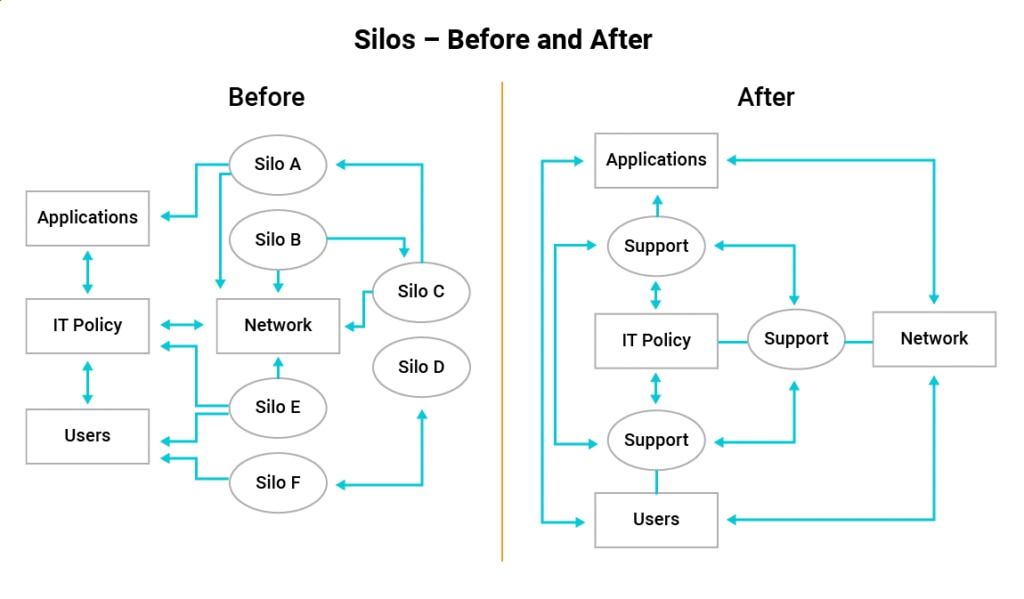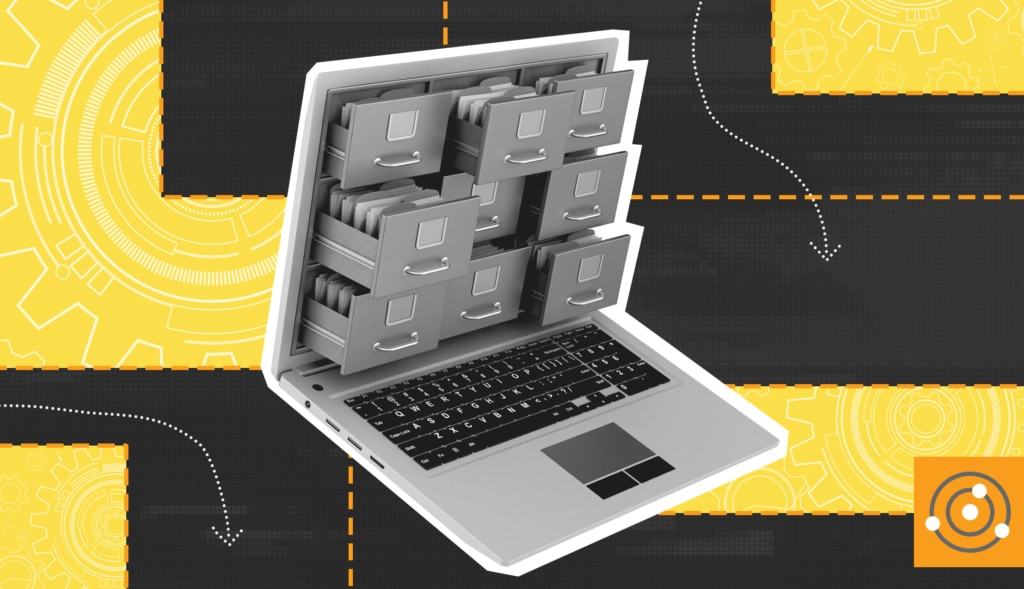“Silo” is a long-standing term that’s too often thrown about in IT organizations. Silos don’t happen overnight, and they’re typically caused by one person or group maintaining control over an application, network component, or tool on which the company has grown dependent.
Silos are still common in IT, but that needs to change—the walls must come down to help the business function at an optimal level of performance and cost.
There are several areas inside an IT department that can become fragmented into their own siloed worlds. The most common of these IT silos can be broken down into four definable areas, each with their own nuances and challenges.
- IT Teams and DevOps
At times, individuals or even entire teams can fragment from the primary IT group collective. These silos can be as small as a single systems engineer who “owns” a particular application, or as large as DevOps-managed cloud siloes hosting vital infrastructure elements or business-critical applications. Regardless of the size or how many silos exist in an organization, they all have negative effects on visibility, communications, and efficiency.
- Cloud, Hybrid, and/or Software Platforms
Siloed devices and software can cause headaches for any company. For example, support options become limited to the go-to individual or team for the asset; and upgrades and installations will feel as if they’re being done under cover of darkness, with little visibility into process or testing. Risks here include the unknown security status of applications and devices and the unknown cost attributes of maintenance.
- IT-Specific Processes
This is arguably the area of IT most at risk due to siloed activities. In this area, the impact of silos can spread across multiple systems and projects, elevating the risks of any project activity. Staff likely hangs onto tasks as “theirs.” This can cause delays in performing “their tasks” when they themselves don’t have the bandwidth to do so. Cost overruns and increased downtime are just some of the effects of siloed IT processes.
- Tools or Utilities
Placing important tools on an island is another example of silos. It could stem from the network team preferring a certain monitoring tool over the one the database team uses, or it could happen organically, with teams choosing different tools as they grow. Regardless of how it happens, inconsistencies in reporting or areas being monitored can lead to serious issues within a corporate infrastructure.
IT Silos Create Inefficiencies and Harm Productivity
Silos in the IT stack result in gross inefficiencies and waste, and can burden an IT budget with high total cost of ownership (TCO) while harming business productivity. Systems performance and reliability also tend to suffer in a fragmented IT environment, causing additional production issues and sinking business confidence throughout the entire IT department.
IT silos hurt the ability to encourage
proactive, cross-team collaboration, leading to budget overruns and eroded project timelines. Inefficiencies can run rampant due to duplication of process execution, money spent on duplicate platforms or tools, or communication mix-ups. Further, it’s important to note these duplications can cause an IT organization to stray from the best-practice strategy of single-pane-of-glass management and into disorganized efforts.
Are Consolidated and Integrated Solutions the Better Way?
Tearing down the silos in your IT organization isn’t as easy as hiring a bulldozer. The streamlining of IT management (see
Figure 1) requires a focused effort to identify and eliminate any silo standing in your IT stack.
This simplifies and integrates IT operations management across the entire environment, providing immediate cost reductions with the platforms, solutions, and tools you use. You’ll also notice an instant improvement in collaboration across teams due to wide-open communication channels.

Figure 1: Differences between siloed IT and integrated IT
The consolidation of vendors and support channels occurs naturally with the elimination of duplicate systems and processes, revealing a welcome upturn in an IT budget.
Removing IT silos is also crucial to reducing mean time to release (MTTR) for processes. The time reduction in your MTTR allows you to achieve a faster ROI on your IT infrastructure and management, adds agility and a lean operational strategy to IT operations, and offers a path to reduced time to value with rapid deployment.
Take Purposeful Steps Toward Ending the Day of the Silo
Eliminating the silos in your IT stack requires using the right tool. Don’t wait to start tearing down your IT silos, since all they do is increase your TCO and limit the return on investment (ROI) of all elements that go into your IT stack. Cleaning up the silos and centralizing IT operations can yield immediate value to your organization—both in terms of ROI and TCO. Also, you’ll be able to leverage your new tool to build and more effectively
monitor hybrid and multi-cloud IT environments, allowing your organization to stay on the cusp of innovation and drive profitability forward.
Looking for a solution built to help teams focus on key issues, so they can make better-informed decisions and reduce remediation time? Learn more about how
SolarWinds Observability Self-Hosted (formerly known as Hybrid Cloud Observability) can provide a holistic and deep view across hybrid and cloud IT infrastructure and services.
 Figure 1: Differences between siloed IT and integrated IT
The consolidation of vendors and support channels occurs naturally with the elimination of duplicate systems and processes, revealing a welcome upturn in an IT budget.
Removing IT silos is also crucial to reducing mean time to release (MTTR) for processes. The time reduction in your MTTR allows you to achieve a faster ROI on your IT infrastructure and management, adds agility and a lean operational strategy to IT operations, and offers a path to reduced time to value with rapid deployment.
Figure 1: Differences between siloed IT and integrated IT
The consolidation of vendors and support channels occurs naturally with the elimination of duplicate systems and processes, revealing a welcome upturn in an IT budget.
Removing IT silos is also crucial to reducing mean time to release (MTTR) for processes. The time reduction in your MTTR allows you to achieve a faster ROI on your IT infrastructure and management, adds agility and a lean operational strategy to IT operations, and offers a path to reduced time to value with rapid deployment.




